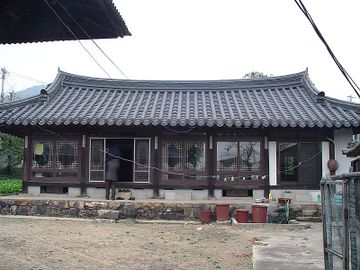김해 시례리 염수당
| 김해 시례리 염수당 Yeomsudang House in Sirye-ri, Gimhae |
|
 김해 시례리 염수당, 국가문화유산포털, 문화재청. |
|
| 대표명칭 | 김해 시례리 염수당 |
|---|---|
| 영문명칭 | Yeomsudang House in Sirye-ri, Gimhae |
| 한자 | 金海 詩禮里 念修堂 |
| 주소 | 경상남도 김해시 진례면 진례로311번길 107 (시례리) |
| 지정(등록) 종목 | 경상남도 문화재자료 제402호 |
| 지정(등록)일 | 2006년 7월 20일 |
| 분류 | 유적건조물/주거생활/주거건축/가옥 |
| 시대 | 조선시대 |
| 수량/면적 | 건물2동(안채, 사랑채)/2,039 |
| 웹사이트 | 김해 시례리 염수당, 국가문화유산포털, 문화재청. |
해설문
국문
염수당은 김해시 진례면 시례리에 지어진 조선후기 부농 주택이다. 약 2,300㎡ 대지에 사랑채, 안채, 가묘, 고방채와 기타 3동의 부속채로 구성되어 있다. 사랑채를 경계로 하여 전통적인 유교 관습에 따라 안과 밖으로 영역을 구분하였다.
사랑채는 우측부터 큰 사랑방, 작은 사랑방, 안마루, 중문간, 중사랑방으로 짜여 있으며 전퇴에는 툇마루, 후퇴에는 벽장 등의 수납공간을 두었다. 큰 사랑방과 작은 사랑방 앞에 예강서원(禮岡書院)이라는 편액*을 달았다. 사랑채는 원래 낙동강변에 무성했던 억새로 지붕을 엮은 샛집이었으나 1971년에 평기와 지붕으로 바꾸었다. 1925년에 지어진 안채는 우측부터 부엌, 안방 2칸, 마루, 건넛방으로 짜여 있으며 앞과 뒤에 퇴칸을 두었다. 안채의 창호 형식과 가구 수법, 부재 규격에 근대가옥의 특성이 잘 나타나 있다.
시간의 흐름에 따라 부엌을 달아내고 마루 끝에 유리문을 다는 등 원래의 모습에서 가옥이 바뀌기도 하였으나 근대기 부농 주택의 특성을 잘 드러낸다.
- 편액(扁額): 건물 정면 문과 처마사이에 설치되어 건물의 명칭, 내역, 제작 이야기 등을 알려주는 액자
영문
Yeomsudang House in Sirye-ri, Gimhae
Yeomsudang House was established in 1854 during the Joseon period (1392-1910) as the residence of a wealthy farmer. The property consists of a gate quarters, a men’s quarters, a women’s quarters, a main shrine, a storehouse, and three auxiliary quarters located on about 2,300 m² of land.
The men’s and women’s spaces are divided in accordance with the Confucian tradition of separation of the sexes. The men’s quarters consists from right to left of a large underfloor-heated room, a small underfloor-heated room, an inner wooden-floored porch, an inner gate, and a middle underfloor-heated room, with a narrow wooden veranda along the front and closet-like storage spaces along the back. It originally had a thatched roof but was given a tile roof in 1971. The building’s name plaque reads “Yegangseowon Confucian Academy,” which refers to the Confucian scholar An Eon-ho (1853-1943, pen name: Yegang), who was born in this village. Sirye-ri Village, where this house is located, is a clan village of the Gwangju An clan. Meanwhile, the women’s quarters, built in 1925, consists from right to left of a kitchen, a main underfloor-heated room, a wooden-floored hall, and an auxiliary underfloor-heated room, with a narrow wooden veranda along the front and back.
Although the house has undergone some modifications over time, such as the addition of a kitchen and the installation of glass doors to enclose the verandas, the house preserves the characteristics of wealthy farmers’ residences of the 19th century.
영문 해설 내용
염수당은 조선시대인 1854년 부농의 주택으로 지어졌다. 약 2,300㎡ 대지에 대문채, 사랑채, 안채, 가묘, 고방채, 3동의 부속채로 구성되어 있다.
이 집은 전통적인 유교 관습에 따라 남성과 여성의 영역을 구분하였다. 사랑채는 오른쪽에서부터 큰 사랑방, 작은 사랑방, 안마루, 중문간, 중사랑방으로 구성되어 있으며, 앞쪽에는 툇마루, 뒷쪽에는 벽장과 같은 수납공간을 두었다. 원래 억새로 지붕을 엮은 건물이었으나, 1971년에 기와 지붕으로 바꾸었다. 현판에는 “예강서원”이라고 쓰여 있는데, 예강은 이 마을에서 태어난 유학자 안언호(1853-1943)의 호이다. 이 집이 위치한 시례리는 광주안씨의 집성촌이다. 1925년에 지어진 안채는 오른쪽에서부터 부엌, 안방, 마루, 건넌방으로 이루어져 있으며, 앞과 뒤에 퇴칸을 두었다.
시간의 흐름에 따라 부엌을 달아내고 마루 끝에 유리문을 다는 등 일부 개조되기도 하였으나 19세기 부농 주택의 특성을 잘 보여준다.
참고자료
- “광주안씨 안경지 선생 후손, 대대로 농사 지으며 160년 간 지켜온 한옥”, 김해뉴스, 2017.07.12. http://www.gimhaenews.co.kr/news/articleView.html?idxno=19032